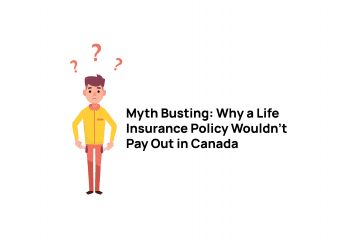When I was new to the insurance industry, I would often have conversations with people, and they would ask me what I did for a living. When I told them I worked as an advisor who helped people set up life insurance plans, it wasn’t uncommon for them to say that life insurance was something they knew they needed, but it was also something that they didn’t have. When we would talk about why they didn’t have any coverage, there were often common themes as to why this was the case. I thought it might be helpful to put together a list of common misconceptions about life insurance and dispel some of the myths you’ve heard so that you can make a choice to get the life insurance coverage you need.
In This Article:
Misconception #1 – Waiting Too Long to Buy Coverage
Misconception #2 – Assuming that Employee Benefits provide you with Enough Coverage
Misconception #3 – Thinking that Mortgage Insurance Covers You
Misconception #4 – You Don’t Apply for Enough Coverage
Misconception #5 – You Bought the Wrong Type of Life Insurance
Misconception #6 – I Don’t Need Life Insurance; I’m not even sick!
Misconception #1 – Waiting Too Long to Buy Coverage
All too often, this is the case. If you remember the old adage, why put off until tomorrow what you can do today? It holds extra truth when you are considering life insurance. With the way premiums are calculated for life insurance, the younger you are when you apply, the lower the premium that you will pay. The other thing that you should remember is that as a young person, your health is probably the best it will ever be. This means that applying for insurance while you are young is the best time to take advantage of this. Another thing that you can take advantage of when you are young is that you may have less family medical history to disclose because your family members are younger as well. For example, if you waited to apply for insurance and in the interim, you have a parent who suffered a heart attack or cancer diagnosis, you now need to disclose this, and it could mean higher rates for you.

Misconception #2 – Assuming that Employee Benefits provide you with Enough Coverage
When people are young, they often look at their employee benefits and see that there is life insurance included. They assume that they have coverage, and that’s all they need. When you explore a bit further, though, you will often see that a benefit plan will only provide you with minimal coverage. It may go as high as two times your annual earnings, but that’s usually the limit. The other issue that relying on group life insurance has is that it is tied to some things that are beyond your control. The first is that it relies on your continued employment. If you change employers or lose your job for any reason, there is no guarantee that your next job will offer you the same benefits. Another instance is that your employer may choose to terminate their benefit plan as a whole, ending your coverage with that decision. As you age, the benefits will also decrease. If you are still working, when you reach age 65, the amount drops by 50%, and at age 71, it ceases completely. This means that as you reach an age where you are more and more likely to need it, the coverage declines and then disappears fully.
Misconception #3 – Thinking that Mortgage Insurance Covers You
This is a common point that comes up in many different conversations, so I will reiterate here. Mortgage insurance is not for you; it is not for your loved ones. Mortgage insurance is a way for your mortgage lender to make sure that they get paid in full if something happens to you. Don’t get me wrong, the idea that you have insurance to take care of your mortgage is commendable. The problem is that if you took the mortgage insurance from your lender, you made a mistake in how you set up your insurance plan. Out of the many downfalls you need to know, one of them is that mortgage insurance is not guaranteed. At the time you pass away, there will be an investigation into your health history that goes all the way back to the application. If you had something existing at that time, the lender might be able to cancel the policy and avoid paying off the mortgage. This is called the time of claim underwriting, and if you see or hear that term, run, don’t walk away from that style of insurance. You need life insurance from an insurance company where the underwriting is done upfront, and you can have 100% confidence that your beneficiaries will be paid if something happens to you.
Get a free quote
Misconception #4 – You Don’t Apply for Enough Coverage
Do we know what a rule of thumb is? It is an expression based on the practice of using someone’s thumb to measure things that they were selling in the 17th century. Do you know what it isn’t? A rule of thumb is not a way for you to guess how much life insurance you need, particularly in the 21st century. If you have someone tell you that you should get two or three times your annual salary as the death benefit amount, and they don’t take the time to discuss and analyze your needs, this becomes another situation that you need to walk away from. We have highlighted many times in the past that there is no rule of thumb for death benefit amounts. There is a needs analysis. You should sit down and look at what debts you would like your beneficiaries to be able to discharge right away if you pass away, what savings goals they will need help achieving on their own, and finally, how much supplemental income you would like to provide to help with day to day household living. This is how you figure out how much insurance you need. If you don’t bother to do this and follow the old advice of getting three times your annual earnings, hopefully, that’s enough money to support your family for decades into the future.
Misconception #5 – You bought the wrong type of Life Insurance
If you don’t know about the differences between permanent and term life insurance, you may end up overpaying for what you need. Don’t get me wrong; I am a huge fan of participating in whole-life insurance that has a death benefit that can grow from the additional insurance purchased by dividends. Participating life insurance and the cash values it contains is a powerful tool that you can leverage into a very important part of your financial plan as you age. That doesn’t mean it is the best solution for every individual, and it doesn’t mean they need insurance, though. If you are at a point in your life when you are paying down your mortgage, saving for kids’ education, raising a family and simply trying to get by on a salary that seemingly loses purchasing power every month, you may be better suited to seek out term insurance. Term insurance is not permanent; it does have an expiration date, and it may include increases in the premiums as you age. However, it gives you the most coverage for the premium dollars you have in your budget today. When you have aspects of your family life that fall outside of simply paying insurance premiums, you need to make sure that you maximize the return on your premium dollars.

Misconception #6 – I Don’t Need Life Insurance; I’m not even sick!
This is a big one. Too often, people wait until it’s too late to get life insurance. Many people think that they are healthy right now, so they don’t feel like they need life insurance. Here’s the thing about insurance in general. No one wants to pay for it until they need it; once this happens, they wish that they had it in place already. I always use the example of fire insurance for your home. If your kitchen is on fire, you really want to have fire insurance in place. The thing is, you need to own it before the fire starts; no one will give it to you after your stove is engulfed in flames. Your health and life insurance are the same thing. You need to get life insurance when you are healthy so that it is established and already in place when you need it. Paying the premiums on a policy for years is a light year better than the alternative of leaving your loved ones high and dry if something unexpected happens and you don’t own it. Planning for the worst is not negative thinking. It is a proactive way to make sure your loved ones are taken care of in the event something you can’t control happens to you.
Conclusion
This is by no means a complete list of mistakes I have seen people make. It is designed to highlight a few of the more common mistakes financial advisors see and help you think about whether you are making the same mistake. The fact that you’re reading this in the first place is a great step in the right direction. My next suggestion would be to connect with a broker who can talk over your needs and run a number of quotes to see what insurer will offer you the best combination of premium and coverage. You won’t be disappointed that you took care of getting life insurance before you needed it. Ready to secure your legacy? Reach out to James Duncan and the expert team at Life Insurance Canada.com , click here to schedule a call.
James Duncan is a Life Insurance Advisor at Life Insurance Canada.com. He can be reached at 877-344-4011.




